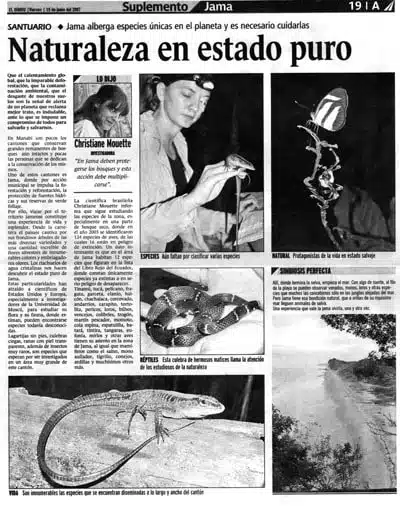 Nature in a Pure State
Nature in a Pure State
That global warming, unstoppable deforestation, environmental pollution, and the wasting of our soils are the planet’s alert signal clamoring for better treatment is beyond doubt, before that which is imposed as a compromise for everyone in order to save it and save us.
In Manabi the cantons are few that maintain large remnants of still intact forest and few are the people who dedicate themselves to the conservation of the same.
One of these cantons is Jama, where by municipal action forestation and reforestation are instituted, along with the protection of hydrological sources and their reserves of green foliage.
Because of this traveling by Jama territory constitutes an experience of life and splendor. From the highway the landscape is held captive by its own leafy trees of the most diverse varieties and an incredible quantity of wildflowers of innumerable colors and intoxicating scents. The streams of crystalline water have us discover the pure state of Jama.
These particulars have attracted American and European scientists, especially researchers from the University of Moscow, to study its flora and fauna, where, it is estimated, one could encounter species as of yet unknown.
Lizards without feet, blind snakes, frogs with transparent skin, no to mention very rare insects, are the species that wait to be researched in an very large area of this canton.
The Brazilian scientist Christiane Mouette states that she continues investigating the species of the region, especially in a part of dry forest, where in 2003 124 species of birds were identified, of which 16 are endangered. An interesting fact is that in the area of Jama live 12 species that are listed in the Libro Rojo del Ecuador (“Ecuador’s Red Book”), comprised only of species that are already extinct or are in serious danger of disappearing.
Tinamu (all I can find when trying to translate this bird name is: “resembling the crow, but having a beak which is singular, from being the length of a hand, and beautifully variegated with a distribution of red, yellow, and black streaks. The water in which the tongue of this bird, which is a feather”), pelicans, frigate birds, egrets, kites, falcons, chachalacas, corcovado (can’t find a good translation for this bird type), lapwings, snipe, doves, parakeets, owls, swifts, hummingbirds, trogons, the fishing martin, mot-mots, spinetails, tody-flycatchers, ant-shrikes, tintira, tanagers, euphonia, thrushes and other birds have their seats in the Jama area, as well as mammals such as the peccary, the howler monkey, oncilla, rabbits, squirrels and many others.
Captions:
What she said:
Christiane Mouette, Researcher
“In Jama they ought to protect the forests and this action should multiply upon itself.”
Photo Captions:
Species Various species have yet to be classified.
Natural The protagonists of life in a wild state.
Reptiles This snake of beautiful hues calls the attention of nature scholars.
Life The species that can be found disseminated the length and breadth of the canton are innumerable.
Perfect symbiosis
There, where the forest ends, begins the ocean. With a little luck, along the blade of the beach one can observe deer, monkeys, parrots and other species that many only conceive to be in the jungles far from the sea. But Jama has this natural blessing, that at the shores of its most rich ocean arrive the animals forest.
An experience that is worth ones while to live, once and many times again.
Translations courtesy Heather Heinz.
